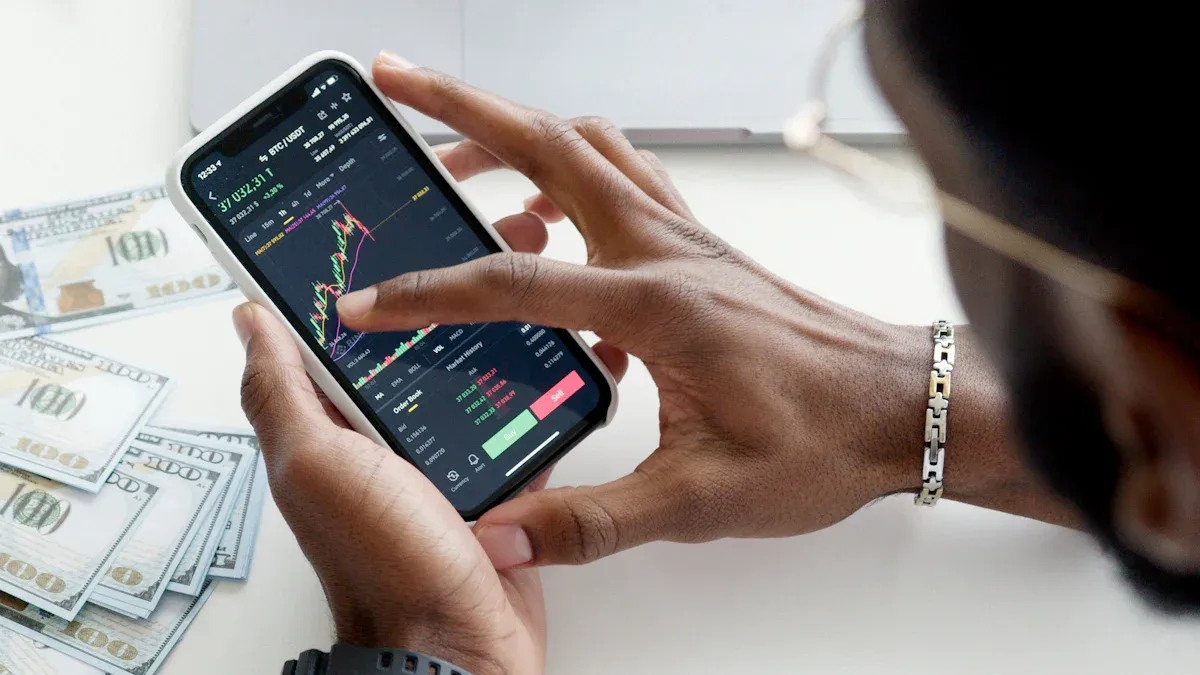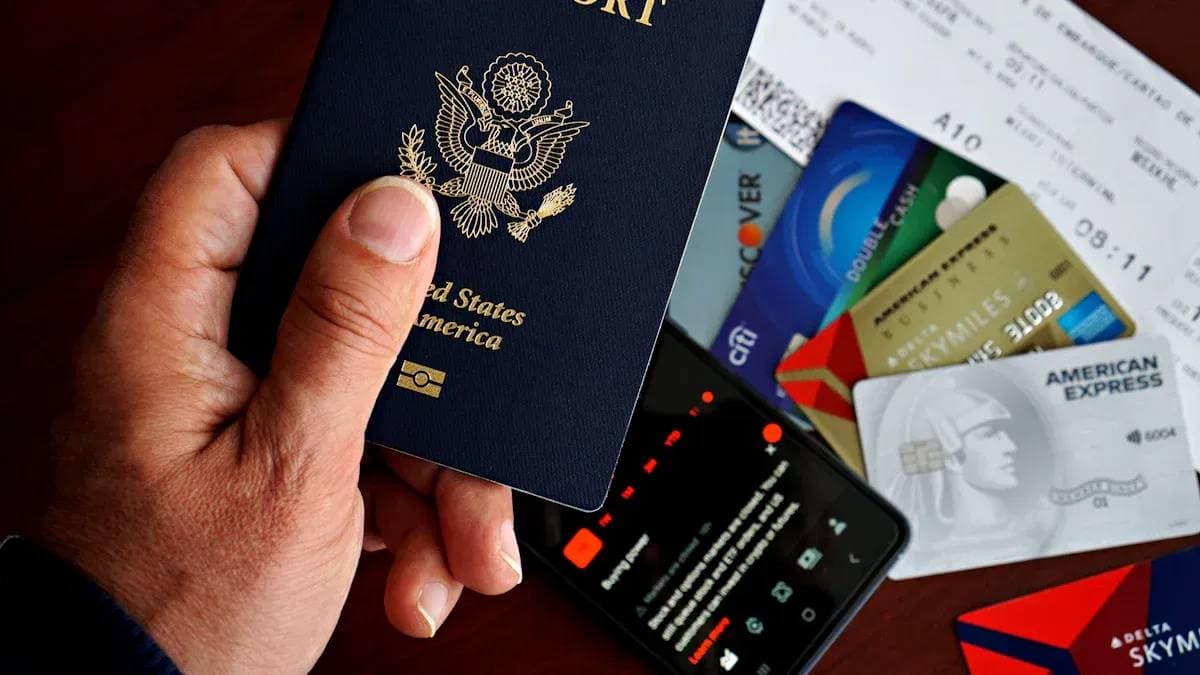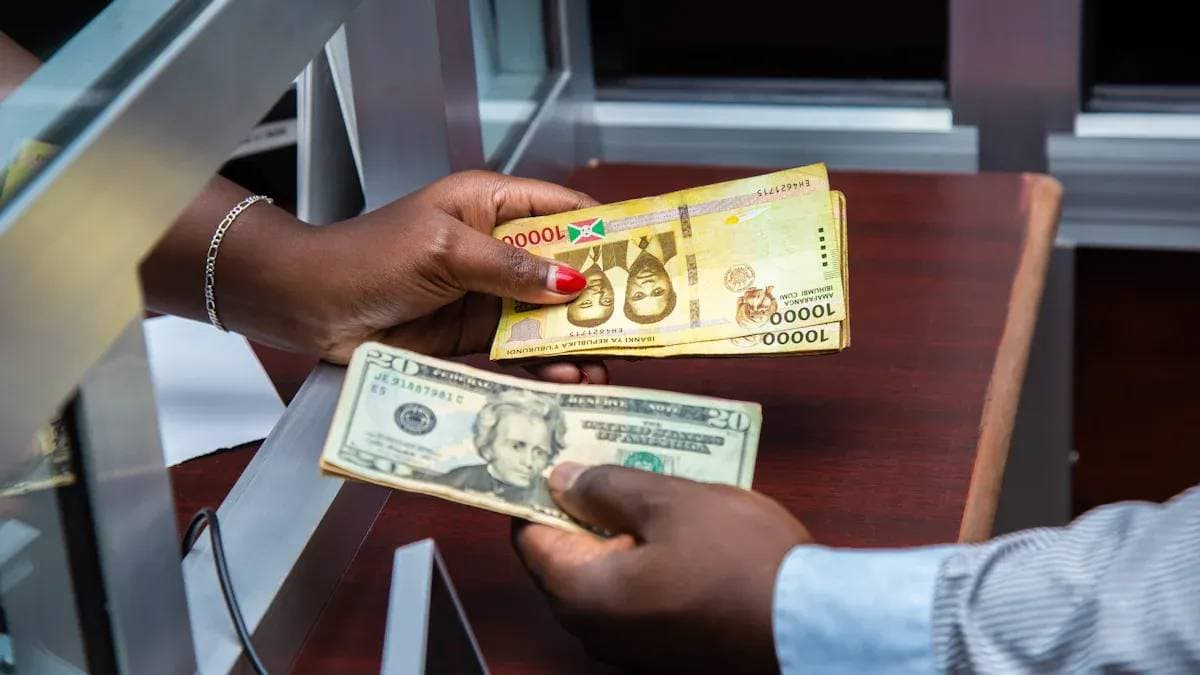- EasyCard
- Trade
- Help
- Announcement
- Academy
- SWIFT Code
- Iban Number
- Referral
- Customer Service
- Blog
- Creator
Still Worried About Bank Transfer Delays? Digital Currency Is Your Better Solution

Image Source: unsplash
Many people encounter delays when conducting international remittances on weekends or holidays. Bank systems typically stop processing transactions during these periods, causing funds to fail to arrive on time. Digital currency transfers provide an efficient solution. Transactions are usually completed in minutes rather than the 1 to 5 days required by traditional banks. It is like sending an email, directly from the payer to the recipient, bypassing all bank intermediaries and operating around the clock.
If traditional bank transfers are like driving on city roads full of traffic lights, then digital currency transfers are like speeding on an unobstructed digital highway.
Core Points
- Digital currency transfers are fast; they have no bank intermediaries, operate around the clock, and automatically complete settlement.
- Digital currency transfers have low fees, eliminating various bank handling fees and currency conversion fees.
- Digital currency transfers allow more people to access financial services; only a smartphone is needed to use them.
- Digital currency transfer records are public and transparent; the destination of every penny can be queried.
- When using digital currency transfers, choosing compliant platforms, securely storing private keys, and confirming recipient addresses are very important.
Why Are Digital Currency Transfers Faster?

Image Source: pexels
The speed advantage of digital currency transfers is not magic but stems from its disruptive underlying technology and operating model. It fundamentally solves three core problems causing delays in traditional banking systems: too many intermediaries, non-24/7 operation, and manual settlement.
Decentralized Peer-to-Peer Network
The cross-border transfer process in traditional banks is lengthy and complex. Imagine a scenario: a user needs to pay a supplier in the US through their licensed bank in Hong Kong. This process typically involves multiple steps:
- Initiate Transaction: The user’s Hong Kong bank receives the instruction, but it may not have a direct business relationship with the US recipient bank.
- Find Intermediary: The bank uses the SWIFT network to find a correspondent bank that cooperates with both banks.
- Fund Transfer: The Hong Kong bank transfers funds to its special account at the correspondent bank (Nostro account).
- Deduct Fees: The correspondent bank processes the transaction and deducts its service fee.
- Final Delivery: The correspondent bank then transfers the remaining funds to the account opened by the US recipient bank with it (Vostro account), finally reaching the supplier’s account.
This chain involving local banks, central banks, correspondent banks, and other parties requires time for verification and processing at each step, and any error in one link can cause overall delays.
Digital currency is completely different. It is built on a peer-to-peer (P2P) network, with funds sent directly from the payer’s digital wallet to the recipient’s digital wallet, just like sending an email, without middlemen profiting from the difference or intermediary links consuming time. Blockchain technology, by eliminating these intermediaries, can reduce the cost of a $10,000 transfer from about $330 to $66, a reduction of up to 80%.
7x24-Hour All-Weather Operation
Traditional financial systems have clear “business hours.” For example, Europe’s TARGET2 payment system operates on weekdays from 07:00 to 18:00 Central European Time, while the US Fedwire funds service is only open on weekdays, closing on weekends and statutory holidays. This means that if you initiate a cross-border remittance on Friday night, the funds may not be processed and delivered until Monday or even Tuesday.
Digital currency networks completely break this limitation. Whether Bitcoin, Ethereum, or other blockchains, they are maintained by computers worldwide, with no central server and thus no concept of “closing time.” This global network operates 7 days a week, 24 hours a day, 365 days a year.
This all-weather characteristic brings great convenience to global business activities. Companies can make payroll, supplier payments, and fund settlements anytime, anywhere, without being limited by bank working hours and time zone differences in different countries. Just as companies like Visa are exploring digital currency technology to significantly shorten the time and complexity of cross-border settlements.
Automated Instant Settlement
In banking systems, “transfer” and “settlement” are two concepts. After a transfer instruction is issued, banks still need to reconcile and clear funds, a process that usually involves manual review and batch processing, especially in anti-money laundering (AML) and compliance checks, which takes even longer.
Digital currency transfers achieve automated instant settlement through “smart contracts” (Smart Contracts). Smart contracts are pre-written code on the blockchain that automatically executes transactions based on set rules. When a transfer occurs:
- Automatic Verification: Nodes in the network automatically verify if the payer has sufficient balance and if the transaction complies with rules.
- Instant Execution: Once verified, the transaction is recorded on the blockchain, and funds are immediately transferred from the owner address to the recipient address. The entire process requires no human intervention.
The table below clearly shows the huge difference between automated settlement and traditional manual reconciliation:
| Feature | Automated Smart Contract Settlement | Traditional Bank Manual Reconciliation |
|---|---|---|
| Speed | Processes thousands of transactions in seconds to minutes | May take days to process the same volume |
| Accuracy | Code executes precisely with almost no errors | Prone to human input or verification errors |
| Intervention | No human approval needed; completes automatically | Relies on manual review, reconciliation, and approval |
| Transparency | All transaction records on blockchain, publicly verifiable | Internal processes, not transparent to users |
Specifically, using stablecoins (like USDT) for transfers results in astonishing arrival speeds. Depending on the underlying blockchain network, confirmation times can be as short as a few minutes or even tens of seconds.
| Blockchain Network | Common Confirmation Count | Average Transaction Time |
|---|---|---|
| USDT (ERC-20 on Ethereum) | 3-30 | 1-10 minutes |
| USDT (TRC-20 on Tron) | 19 | Less than 1 minute |
This code-driven automated settlement completely eliminates delays and uncertainties from manual processes, ensuring funds arrive securely in near real-time.
More Than Just Fast: Additional Advantages of Digital Currency
Speed is just the starting point of digital currency’s appeal. Upon deeper understanding of its operating mechanisms, people discover it also offers advantages in cost, financial inclusion, and transparency that traditional systems cannot match.
Significantly Reduce Transaction Costs
Traditional bank international wire transfers are expensive. The cost of a transaction typically consists of multiple parts, including sending bank fees, intermediary bank processing fees, and up to 2-5% currency exchange rate spreads. For businesses, total fee losses accounting for 4% of the transfer amount when paying overseas are common.
Digital currency transfers, especially using USD-pegged stablecoins (like USDC or USDT), can drastically cut these expenses. Since both parties use the same digital asset, the currency conversion link is completely eliminated. Transactions occur directly on the blockchain, bypassing all fee-charging bank intermediaries.
Clear Cost Comparison Assuming a $1,000 international transfer, the cost differences between methods are huge:
| Payment Method | Transfer Fee | Currency Conversion Fee | Intermediary Bank Fee | Total Cost |
|---|---|---|---|---|
| SWIFT Bank Transfer | $30 – $50 | 2-5% ($20 – $50) | $10 – $30 | $60 – $130 |
| PayPal/PSP Transfer | 3% ($30) | 2.5% ($25) | $0 | $55 |
| Stablecoin | $0.50 | 0% | $0 | $0.50 |
Data shows stablecoin payments are over 90% cheaper than traditional bank wires, saving individuals and businesses significant unnecessary expenses.
Global Inclusion and Financial Accessibility
A large population worldwide is still excluded from modern banking services.
- According to World Bank reports, approximately 1.4 billion adults globally lack bank accounts.
- This number is close to 17% of the global adult population.
For these “unbanked” groups, opening a bank account may have high barriers, or there may be no bank branches in their areas. Digital currency provides them with a brand-new solution. Users only need a smartphone with internet access to create a digital wallet and start receiving and sending funds. This greatly lowers the threshold for participating in the global economy, making financial services reach every corner of the world.
Transparent and Traceable Transactions
One core feature of blockchain technology is public transparency. Every transaction is recorded on a public, tamper-proof ledger. Anyone can query transaction details through a “blockchain explorer” tool.
- Transaction Hash (TxID): Unique ID for each transaction, used to track status.
- Sender/Recipient Address: Records the source and destination of funds.
- Status: Shows if the transaction is “pending,” “confirmed,” or “failed.”
This transparency ensures clear and verifiable fund flows, effectively preventing fraud and errors. Additionally, blockchain’s “programmability” offers vast imagination for business applications. For example, charities can use this technology to allow donors to track the final use of donations in real time, ensuring every penny is used properly, just like the World Food Programme’s “Building Blocks” project.
How to Start Digital Currency Transfers?

Image Source: pexels
Starting an efficient digital currency transfer journey is very simple. Users only need to follow the four steps below to easily complete setup and their first transfer.
Choose and Set Up a Digital Wallet
The user’s first task is to choose a digital wallet. A wallet is a tool for storing, sending, and receiving digital currency. It mainly comes in two types: software wallets and hardware wallets.
| Feature | Software Wallet (Hot Wallet) | Hardware Wallet (Cold Wallet) |
|---|---|---|
| Security | Lower security, connected to the internet | Extremely high security, private keys stored offline |
| Convenience | Very convenient, suitable for daily small transactions | Less convenient, requires device connection for transactions |
| Cost | Usually free | Requires purchase, priced between $50 and $200 |
| Use Case | Frequent, small daily payments | Long-term, large asset storage |
For beginners and daily users, software wallets like MetaMask or Trust Wallet are popular due to their convenience.
Acquire Stablecoins Through Compliant Platforms
After having a wallet, users need to exchange fiat currency (like USD) for stablecoins (like USDT or USDC). This needs to be done through a compliant trading platform. Platforms like Biyapay allow users to purchase stablecoins via bank transfer or credit card.
Understand the KYC Process To comply with anti-money laundering regulations, compliant platforms require users to complete “Know Your Customer” (KYC) verification. Users typically need to provide the following information:
- Full name and date of birth
- Government-issued ID (such as a passport)
- Proof of address (such as a recent utility bill)
This process ensures the legitimacy and security of all transactions.
Enter Address and Initiate Transfer
After acquiring stablecoins, initiating a transfer is as simple as sending an email. Users just open the wallet, select “send,” then enter the recipient’s wallet address and transfer amount.
Note: Address Format is crucial! Different blockchain networks use different address formats. For example, Ethereum network (ERC-20) addresses start with “0x”, while Tron network (TRC-20) addresses start with “T”. Before sending, be sure to confirm with the recipient that the address and network are correct, otherwise funds may be permanently lost.
Confirm Arrival and Fund Conversion
After the transaction is sent, users can track its status on a blockchain explorer using the transaction ID. When the transaction receives a sufficient number of “confirmations,” it means the funds have arrived safely. The recipient can then convert the received stablecoins back to local fiat currency through cryptocurrency exchanges or P2P platforms.
Safety First: What Do You Need to Pay Attention To?
Although digital currency transfers are efficient, users must prioritize security. Entering this new field, understanding and adopting correct security measures is crucial. This ensures users’ funds are properly protected while enjoying high-speed circulation.
Choose Compliant Trading Platforms
Choosing a secure and compliant trading platform is the first line of defense for protecting funds. Compliant platforms, such as Biyapay, strictly adhere to financial regulatory requirements and provide safeguards for users. These platforms typically implement the following key measures:
- Identity Verification (KYC): Require users to provide identity proof to prevent illegal activities.
- Anti-Money Laundering (AML): Monitor transaction flows, identify and report suspicious fund activities.
Non-compliant platforms lack regulation and pose extremely high security risks. For example, in July 2023, the cross-chain bridge protocol Multichain was hacked due to a security vulnerability, resulting in user losses of about $210 million in assets. Choosing regulated platforms minimizes such risks.
Properly Store Private Keys and Seed Phrases
Private keys and seed phrases are the only keys to users’ digital assets; once leaked, assets are permanently lost.
Core Principle: Never share your private key or seed phrase with anyone; platform customer service will never ask for this information.
Hackers often use phishing emails or fake websites disguised as official platforms to trick users into entering private keys or seed phrases. To ensure security, users should take the following storage measures:
- Physical Backup: Write the seed phrase on paper and store it in a fireproof and waterproof safe.
- Offline Storage: Use a hardware wallet (cold wallet) to store large assets, as it completely isolates private keys from the internet.
- Never Screenshot or Store Online: Avoid saving private keys or seed phrases on connected computers, phone galleries, or cloud storage.
Understand Price Volatility Risks
Although cryptocurrencies like Bitcoin have drastic price fluctuations, in transfer scenarios, users can choose stablecoins to avoid this risk. Stablecoins (like USDC) are digital currencies pegged 1:1 to fiat currencies like the USD.
USDC maintains its value stability by holding sufficient cash and short-term US Treasury bonds as reserves. If USDC’s market price is slightly above $1, arbitrageurs mint new USDC to sell, increasing supply to bring the price down. Conversely, if the price is below $1, they buy and redeem for USD, reducing supply to raise the price. This mechanism ensures that the value received during transfers is essentially the same as sent, avoiding losses due to price fluctuations.
Digital currency, with its decentralized, all-weather operation, and automated settlement characteristics, effectively solves the three major pain points of traditional bank transfers: delays, high costs, and complex processes. For users pursuing speed and low cost, especially in cross-border payment scenarios, it offers a highly attractive better solution.
As industry experts predict, stablecoins are accelerating to become mainstream and may even be directly called “currency” in the future.
Actively understanding and using this emerging tool means saying goodbye to long transfer waits and embracing a more efficient global financial future.
FAQ
Are Digital Currency Transfers Legal?
The legal status of digital currencies varies by country and region. Users should actively understand and comply with relevant laws and regulations in their location before use. Choosing platforms compliant in the local area is an important step to ensure operations meet standards.
What If the Transfer Address Is Wrong?
Note: Blockchain transactions are usually irreversible.
If funds are sent to a wrong or non-existent address, they will likely be permanently lost and unrecoverable. Therefore, users must repeatedly confirm that the recipient address and network type are completely correct before initiating a transfer.
Are Digital Currency Transfers Completely Anonymous?
No. Although transaction addresses do not directly display personal names, all transaction records are publicly verifiable on the blockchain. Transactions conducted through compliant platforms have user identities verified via KYC. Therefore, they are traceable rather than anonymous.
*This article is provided for general information purposes and does not constitute legal, tax or other professional advice from BiyaPay or its subsidiaries and its affiliates, and it is not intended as a substitute for obtaining advice from a financial advisor or any other professional.
We make no representations, warranties or warranties, express or implied, as to the accuracy, completeness or timeliness of the contents of this publication.




Contact Us
Company and Team
BiyaPay Products
Customer Services
BIYA GLOBAL LLC is a licensed entity registered with the U.S. Securities and Exchange Commission (SEC No.: 802-127417); a certified member of the Financial Industry Regulatory Authority (FINRA) (Central Registration Depository CRD No.: 325027); regulated by the Financial Industry Regulatory Authority (FINRA) and the U.S. Securities and Exchange Commission (SEC).
BIYA GLOBAL LLC is registered with the Financial Crimes Enforcement Network (FinCEN), an agency under the U.S. Department of the Treasury, as a Money Services Business (MSB), with registration number 31000218637349, and regulated by the Financial Crimes Enforcement Network (FinCEN).
BIYA GLOBAL LIMITED is a registered Financial Service Provider (FSP) in New Zealand, with registration number FSP1007221, and is also a registered member of the Financial Services Complaints Limited (FSCL), an independent dispute resolution scheme in New Zealand.



















